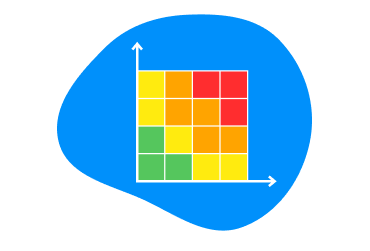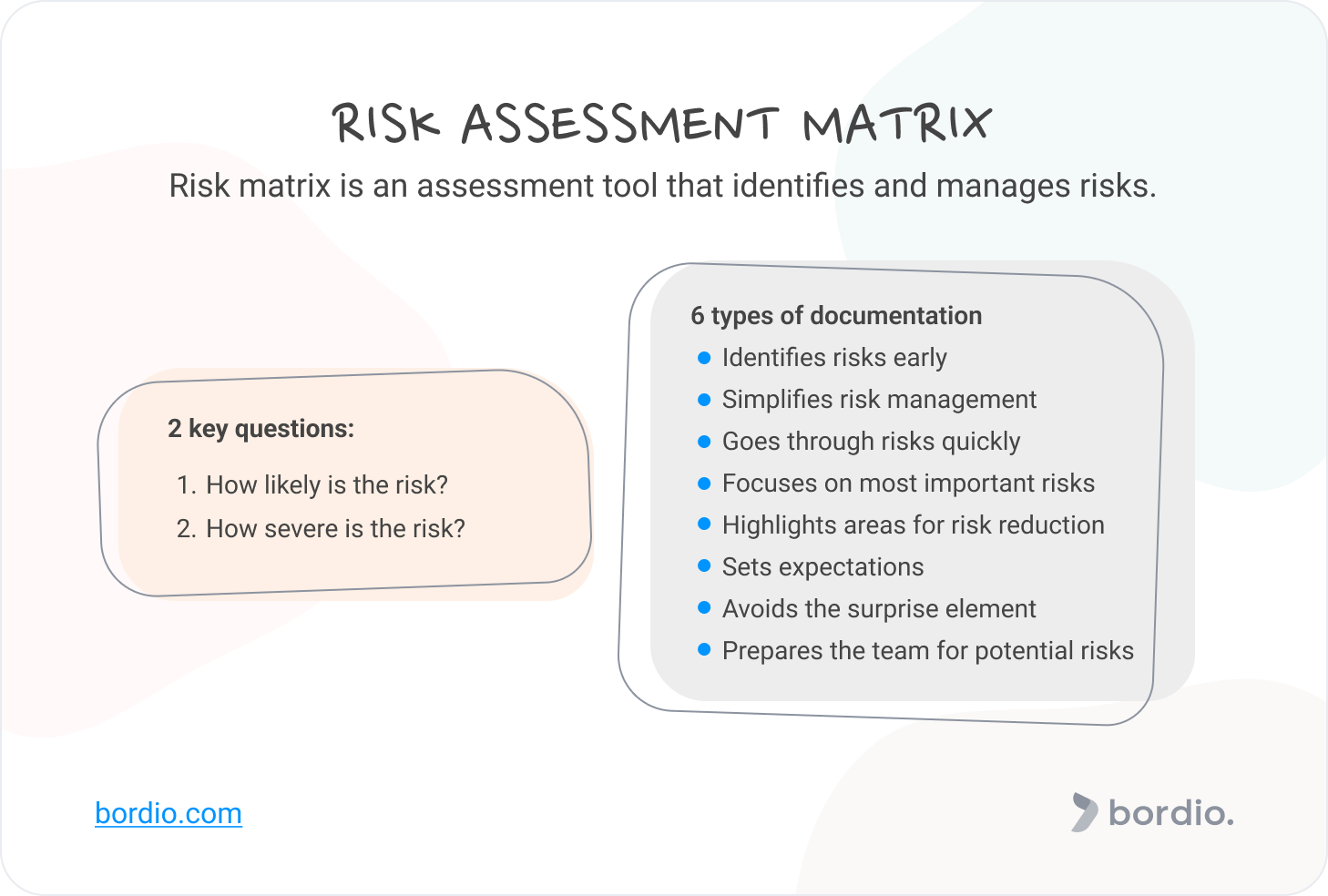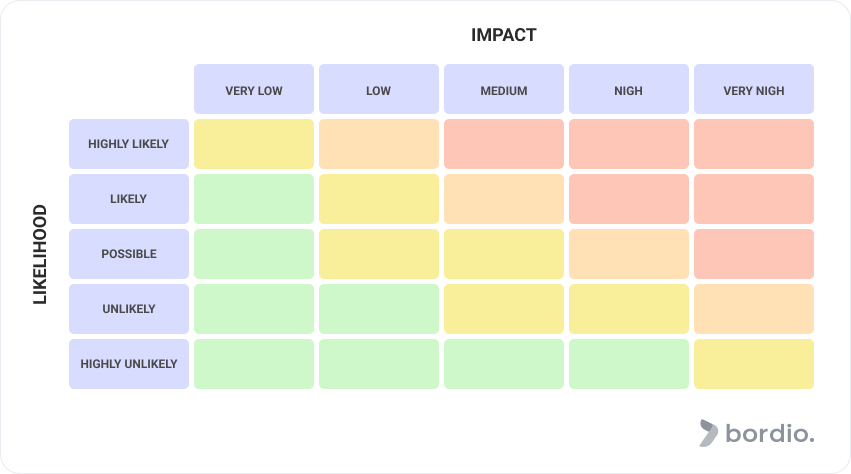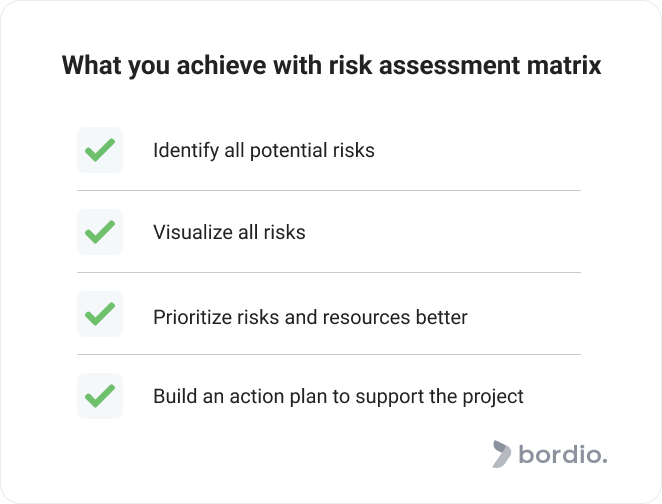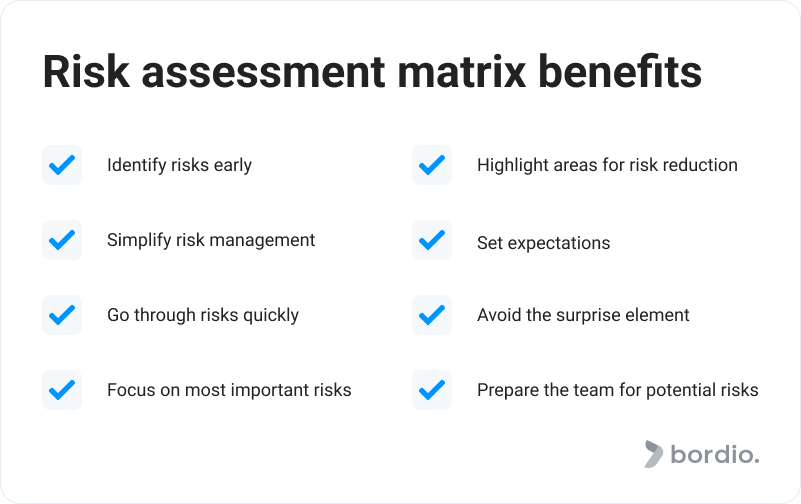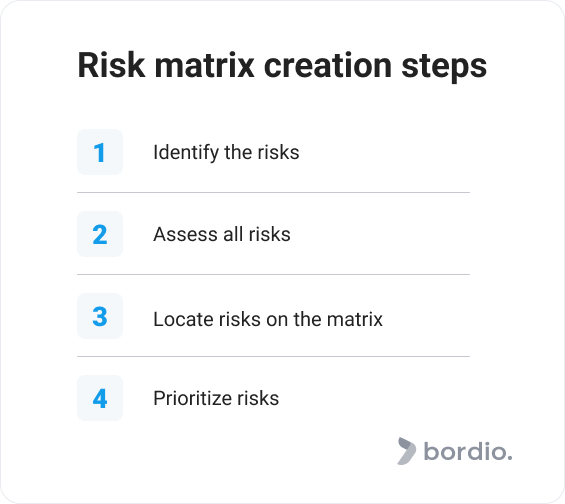Risks and project management go hand in hand. Like Batman and Joker, Sherlock and Moriarty, those two seem to follow each other whenever they go.
Unfortunately, such a tight bond is toxic to the projects and must be limited.
Project management of today knows and practices many tools and techniques designed to mitigate project risks and minimize their negative effect on the whole process.
Among those tools is the risk assessment matrix – one of the proven ways to identify and manage risks so they don’t take over and ruin our professional lives.
What is the Risk Assessment Matrix?
The risk assessment matrix in project management is essentially a tool used to calculate project risks.
Here is what it looks like:
In the process of designing the risk matrix, we answer the two following questions:
- How likely is the risk to happen?
- How severe is the risk?
The answers provide a 360 view of the potential threats and serve as a base for successful risk management.
What does the risk matrix do?
The risk assessment matrix helps project managers achieve several goals while managing tasks from their schedule planners.
#1 Identify all potential risks and threats
Risk identification is, obviously, the number one role and priority of the risk matrix.
Countless projects fail because they do not invest enough time and energy into risk management. And we can understand that! It can be really daunting to spend hours brainstorming all the things that can go wrong.
It’s like sitting one day before your wedding thinking about all the ways your life with the future spouse can go wrong. Surely, no one wants to do that!
However, proper risk management is something that needs to be done in order to increase the chances of a positive project outcome. Thankfully, the risk matrix allows going through the risk analysis process with minimal time and maximum benefit.
#2 Visualize all project risks
It’s one thing to have the data, but it’s a completely different story to use it.
Risk analysis can look like a boring excel sheet with countless rows of information. Or it can be presented in a visual format that is more welcoming and easy to work with.
Now, it might seem like not a big deal but trust us – there’s nothing quite as effective as colorful visuals when it comes to utilizing information and incorporating it into the project management process.
A general tip for all projects: The more gamification and fun elements you integrate into the project execution, the better results you can hope for. Bordio’s online calendar planner, for example, allows setting different colors for various task types. So when you open modern online planner, you can instantly see what activity takes the most time in the week, and what you’re up to on the given day. Also take a look at Bordio’s schedule builders, these are also very helpful for planning.
#3 Better risk and resource prioritization
Having a risk assessment matrix in place provides clarity. We (more or less) don’t have any surprises that we’ve not anticipated, so we can do a better job of planning and allocating resources better.
It is also easier to prioritize the issues in our to-do lists online because we can see the bigger picture. It’s like when you are building a house and worry about the color of the outer wall being slightly off, instead of giving your full attention to the risk of walls falling off because they weren’t engineered and built correctly. It’s obvious what’s more important when you can compare the two, but not so much when you have to deal with them 1 by 1 as they happen.
Utilizing risk matrix helps you not waste too much time and resources on things that are not that important in the end. So make sure to prioritize and organize tasks.
#4 Сreate an action plan to keep the project running
When something bad happens, whether in personal life or at work, we often feel panic or despair, and we tend to appear lost for some time.
If a risk occurs in the project, we can’t really afford the downtime because:
- We are on a tight schedule.
- The risk can escalate and become uncontrollable.
So, if we’ve identified as many unforeseen circumstances as possible, put all risks in one place, did the risk evaluation, and created an action plan, we will be more prepared for when the risk happens. And we will not waste precious time.
Tip: If you do end up wasting time and find yourself behind schedule, catch up using fast tracking while using time planner calendar, which helps work through tasks faster by doing several things at a time.
Benefits of the Risk Assessment Matrix
There are so many benefits to using the risk assessment matrix! We cannot recommend it enough. Project managers have enough responsibilities to worry about, they don’t need to be stressing about risks too.
Here are the main upsides the risk matrix provides:
-
It allows us to identify potential risks early in the game. The sooner we know about them, the less chance they have to negatively affect the project life cycle.
-
Simplifies risk management with a user-friendly visual representation format. It is a very simple technique in general, you won’t require special training or tons of previous experience to use it right.
-
It is a relatively quick and straightforward technique that deals with key risk criteria, so we don’t waste much time working through the matrix.
-
Links events’ probability and likely consequences, so project managers and the team can group and prioritize the risks.
-
Helps see and focus on what’s most important: top severity and high-risk probability. We only have that much time when working on the project, so our energy has to be where it is needed the most.
-
Highlights potential areas for risk reduction. If we know about the potential issues, we can build risk mitigation plans to remove at least some of them. And in project management, even one risk that’s taken off the table is already a win.
-
Sets expectations and removes the surprise element (which no one wants when it comes to projects and risks). It’s always better to come prepared and not have an issue jeopardize the project progress.
-
Prepares the team. Everyone’s aware of what’s (potentially) coming, so they stay more alert, spot things early on, and help with creative ideas and general collaboration. That makes managing risks less of a headache.
Risk categories
As you work on risk identification, you might need some help or guidance that would support your thinking flow. One way to ensure you come up with as many risks as possible is to think about different risk categories that can remind you of threats that would otherwise be missed or forgotten.
Here are the main risk categories:
-
Strategic risks occur when we make wrong business decisions or fail to consider something. For example, poor target audience analysis can result in building a product that the customer will not be willing to pay for. Mentioning this we can advise to trust only professionals in marketing and for example to use marketing agencies for startups.
-
Operational risks are mainly associated with unoptimized or overall poorly planned internal processes. For example, when the team doesn’t work with smart day planners, so they get behind and miss deadlines.
-
Financial risks can result from poor financial planning and budgeting, like when we underestimate the cost of development or plan for fewer people in the team than we end up needing.
-
External risks are often related to force majeure. A tornado can hit our production site, a global pandemic can freeze the supply chain, and financial sanctions can cut us off from our partners.
Risk assessment criteria
Risk matrices use two key criteria for risk assessment – it is the likelihood of the risk and its’ potential impact on the project.
Risk likelihood (probability) can be estimated using different formats but it’s best to keep it simple. Here are the two most common scales:
- Highly unlikely – unlikely – possible – likely – highly likely.
- Rare – unlikely – possible – probable – very probable.
The impact is usually estimated like this:
- Very low
- Low
- Medium
- High
- Very high
Create your own Risk Assessment Matrix
Now that we’ve promoted and praised the risk assessment matrix, it’s time to tell you how to build one in your online task tracker.
#1 Identify the risks
We always start with risk identification.
The best practice is to have group brainstorming meetings to get multiple team members’ and stakeholders’ perspectives. Such events are most efficient when scheduled in the early project days, in tools for time management, for example as a part of project baselining.
To make the most out of those creative sessions, ask everyone to prepare their thoughts beforehand and have them emailed to you or logged in their online weekly planners. You can go through the list, cross out the duplicates, and share the final product with everyone before the meeting starts. That way you won’t be spending everyone’s time discussing the obvious threats.
#2 Assess risks: their likelihood and impact
Risk assessment is the key element of the process. It’s important that we carefully evaluate each of the identified risks. Because if we miscalculate the risk severity and its negative consequences spiral out of control, it can kill all the effort that we’ve put into the project planning and preparations.
Use the criteria we discussed above to do the risk assessment, and don’t forget to rely on your previous experience and team members’ input.
#3 Locate the risks on the matrix accordingly
The risk assessment matrix works through visualization. That’s why we need to take all the risks that we have identified in step one and put them on the matrix. Literally.
#4 Prioritize the risks for further work
Now that all of the risks are on the matrix, you can see their likelihood and severity, it’s time to prioritize them and start working through them.
The most logical thought would be to focus on the top severity and highest probability risks, but it is not a universally perfect plan. Depending on the circumstances, you might want to first cross off a few less pressing risks if it only takes a tiny bit of time and effort.
Also, if you have enough resources at hand, you might work on several risks simultaneously. Some of those risks will be less important than others, but they are still risks. So it might be feasible to mitigate or eliminate them along with the most pressing project risk.
Tip: Review your matrix regularly. Risks are not standing still, external situations also tend to change. Make sure your risk assessment is up to date and you’re not missing anything important.
Final thoughts on risk assessment matrix in project management
The main superpower of the risk assessment matrix is that it takes something as big and scary as risk management, and gives us a strategic mindset for dealing with it.
The tool breaks down the risks into logical categories, and the visual (colorful) demonstration of the whole picture makes it fun to work with.
But although the risk assessment matrix is a renowned tool, don’t forget that it is only a basis for your risk management process. Yes, it helps identify risk likelihood and potential severity, but that risk may or may not happen. There are no guarantees. Some risks will turn out to be less damaging than we’ve expected, and some will be more destructive than we could have thought. Some risks won’t happen at all.
So, with such an important matter as risk management, it’s crucial to not rely on just one magic trick to save the day. Instead, use a combination of tools, solutions, and practices. It might be a good idea to look at several methodologies that differ in their take on risk management and project execution in general. A good starting point would be to read about Agile, Scrum, Lean, Waterfall, and PRINCE2.
And, as always, engage your team in brainstorming and ask for their advice. Two heads are better than one.
In the meantime, have a look at our top project management books and best time management books lists and our daily schedule maker tool. We are sure you’ll find a lot of inspiration and new ideas there.
